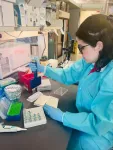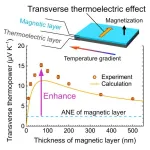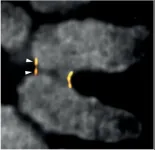(Press-News.org) A newly discovered Zika virus-specific synthetic molecule is capable of differentiating Zika-immune patient samples from samples of patients previously infected with the related dengue virus. The technology may lead to the development of better diagnostics and vaccine candidates, scientists announced today in the Proceedings of the National Academy of Sciences.
The study, led by researchers at the University of Pittsburgh School of Public Health and The Herbert Wertheim UF Scripps Institute for Biomedical Innovation & Technology, is the first to apply an innovative “epitope surrogate” technology to Zika. Until now, researchers and clinicians have lacked diagnostic tools to easily differentiate between prior infections with different flaviviruses, a family of mostly mosquito- and tick-borne viruses that include Zika and dengue. This has posed challenges for clinical-epidemiologic studies, viral diagnostics and vaccine development.
“If you go to places like Brazil, nearly everybody is going to have some immunity to dengue, and also to Zika,” says first author Priscila Castanha, Ph.D., an assistant professor in the Department of Infectious Disease and Microbiology at Pitt Public Health. “This makes it very difficult to test new treatments or determine how widespread an emerging disease may be in areas endemic for flaviviruses, which cause a high burden of illness globally.”
Antibodies for Zika virus, a mosquito-borne virus that spread to the Americas in 2015 and still causes sporadic disease, can be confused in many diagnostic tests with antibodies for dengue virus, making it difficult to tell if someone who tests positive previously had dengue, Zika or both. It is especially important for reproductive-age women to know if they already had Zika – and likely have immunity – because infection during pregnancy can cause birth defects. Knowing if they have immunity or not could guide the extent of people’s efforts to avoid mosquitoes in endemic areas during pregnancy.
The research team used an approach pioneered by co-senior author Thomas Kodadek, Ph.D., a chemist with The Wertheim UF Scripps Institute to screen half a million “peptide-inspired conformationally constrained oligomers,” or PICCOs, against blood samples from people infected with dengue or Zika virus. The PICCOs are nonorganic molecular shapes hooked onto microscopic plastic beads. They mimic epitopes, which are the parts of a pathogen that an antibody would connect to in order to neutralize the threat.
If any of the PICCOs match the corresponding shape of an antibody in the blood sample, the antibody will hook onto them and researchers can “fish” it out. The presence of an antibody against a virus in someone’s blood means that they were previously infected with or vaccinated against that virus, prompting their immune system to produce antibodies.
“The technology is amazing. You don’t need to know the sequence, or the structure, or even the pathogen,” said co-senior author Donald Burke, M.D., Pitt Public Health dean emeritus. “As long as you have chosen the right sets of patient blood samples to compare, you can tease out the important antibodies that differ between the patient sets, along with the corresponding synthetic molecule biomarkers.”
The researchers identified 40 PICCOs that engaged Zika virus antibodies. After screening against dengue-positive blood, one PICCO, dubbed CZV1-1, was particularly good at hooking Zika antibodies, but not dengue. This single CZV1-1 PICCO synthetic molecule correctly identified people previously infected with Zika virus 85.3% of the time and only generated false positives in 1.6% of tests, rates comparable to COVID-19 antibody tests.
Castanha, Burke and co-senior author Ernesto T.A. Marques, M.D., Ph.D., associate professor in Pitt Public Health’s Department of Infectious Disease and Microbiology, have been studying Zika virus since it emerged in the Americas in 2015. Prior to its emergence in Brazil, Castanha, Marques and Burke were studying dengue virus.
“For every sample we tested during the 2015 outbreak, we had to do 10 different blood tests to confirm Zika,” said Castanha. “These tests are technically difficult and time-consuming, making them impractical for providing clinical guidance. I think if we had this molecule back then, it would’ve been fantastic.”
The ability for diagnostics to differentiate between flavivirus antibodies is important in clinical-epidemiological studies. Marques and Burke previously showed that for Zika virus and dengue virus, patient outcomes differ based on prior exposure, which poses challenges to prevention, diagnosis and care.
Importantly, the PICCO screening technology used to identify the Zika-specific molecule doesn’t require refrigeration and could also be used for other outbreaks.
“The molecule is a molecular mimic that cannot unfold,” Kodadek said. “That means there’s no cold chain required, making it particularly useful for outbreaks occurring in remote or low-resourced areas.”
Additional authors on this study are Patrick J. McEnaney, Ph.D., and Paige Dickson, Ph.D., both of The Wertheim UF Scripps Institute; Yongseok Park, Ph.D., Anthea Bouwer, Ph.D., and Jodi Craigo, Ph.D., all of Pitt; Elton Chaves, Ph.D., Roberto Lins, Ph.D., and Marli T. Cordeiro, M.D., all of Oswaldo Cruz Foundation in Brazil; Nicholas G. Paciaroni, Ph.D., and Graham Carlson, Ph.D., both of Deluge Biotechnologies in Florida; and Tereza Magalhães, Ph.D., of Texas A&M University and Universidade Federal da Bahia in Brazil.
This research was funded by a grant from the National Institute of Allergy and Infectious Diseases (R01AI127677).
END
New synthetic biomarker technology differentiates between prior Zika and dengue infections
2024-05-13
ELSE PRESS RELEASES FROM THIS DATE:
Fruit fly testes offer potential tool against harmful insects
2024-05-13
A way to curb nagging insects has been flying under our radar—an enzyme from fruit fly testes.
The compound could control bugs that carry disease and harm crops by stunting their ability to procreate, Johns Hopkins University researchers found.
“We have a toe in the door to control fruit fly populations with this enzyme,” said Steven Rokita, a professor of chemistry at Johns Hopkins who led the research. “It could offer a good way to control fertility of all kinds of biological and agricultural pests, starting with mosquito populations.”
The findings are set to publish ...
Exceptionally large transverse thermoelectric effect produced by combining thermoelectric and magnetic materials
2024-05-13
1. A NIMS research team has demonstrated for the first time ever that a simple stack of thermoelectric and magnetic material layers can exhibit a substantially larger transverse thermoelectric effect—energy conversion between electric and heat currents that flow orthogonally to each other within it—than existing magnetic materials capable of exhibiting the anomalous Nernst effect. This mechanism may be used to develop new types of thermoelectric devices useful in energy harvesting and heat flux sensing.
2. Seebeck effect-based ...
Researchers identify fastest rate of natural carbon dioxide rise over the last 50,000 years
2024-05-13
CORVALLIS, Ore. – Today’s rate of atmospheric carbon dioxide increase is 10 times faster than at any other point in the past 50,000 years, researchers have found through a detailed chemical analysis of ancient Antarctic ice.
The findings, just published in the Proceedings of the National Academy of Sciences, provide important new understanding of abrupt climate change periods in Earth’s past and offer new insight into the potential impacts of climate change today.
“Studying the ...
Research on centromere structure yields new insights into the mechanisms of chromosome segregation errors
2024-05-13
Researchers from the Kops group in collaboration with researchers from the University of Edinburgh, made a surprising new discovery in the structure of the centromere, a structure that is involved in ensuring that chromosomes are segregated properly when a cell divides. Mistakes in chromosome segregation can lead to cell death and cancer development. The researchers discovered that the centromere consists of two subdomains. This fundamental finding has important implications for the process of chromosome segregation and provides new mechanisms underlying erroneous divisions in cancer cells. The research was published in Cell on May 13th 2024.
Our bodies consist of trillions of ...
Ochsner Medical Center-Baton Rouge earns Acute Stroke Ready Certification from Joint Commission
2024-05-13
BATON ROUGE, La. – Ochsner Medical Center - Baton Rouge has earned The Joint Commission’s Gold Seal of Approval® and the American Stroke Association’s Heart-Check mark for Acute Stroke Ready Certification.
The designation means OMC-Baton Rouge meets The Joint Commission's designation for readiness to treat patients who experience severe stroke.
To achieve certification, OMC-Baton Rouge underwent a rigorous, unannounced onsite. During the visit, a team of Joint Commission reviewers evaluated compliance with numerous certification standards, including ...
CEHD researchers studying family-led early childhood systems change for educational equity
2024-05-13
CEHD Researchers Studying Family-Led Early Childhood Systems Change For Educational Equity
Colleen Vesely, Associate Professor, College of Education and Human Development (CEHD); Bethany Letiecq, Associate Professor, Research Methods, CEHD; Rochelle Davidson Mhonde, Assistant Professor, Global and Community Health; and Jung Yeon Park, Assistant Professor of Quantitative Research Methods, School of Education, received funding for the project: “Family-Led Early Childhood Systems Change ...
Raz receives funding for Intent-Based Orchestration In Distributed Command & Control (IBODC2) software
2024-05-13
Raz Receives Funding For Intent-Based Orchestration In Distributed Command & Control (IBODC2) Software
Ali ...
Kelly receives funding for civil war graffiti preservation
2024-05-13
Kelly Receives Funding For Civil War Graffiti Preservation
Mills Kelly, Senior Scholar and Former Director, Roy Rosenzweig Center for History and New Media (RRCHNM); Professor, History, has received funding from the National Endowment for the Humanities for: “Off the Wall: Digital Preservation of Civil War Graffiti Houses.”
Kelly will use the funding to support the building and publishing of a digital archive focused on soldiers’ graffiti found in Civil War-era structures located in the ...
New viruses on the horizon
2024-05-13
Suddenly they appear and - like the SARS-CoV-2 coronavirus - can trigger major epidemics: Viruses that nobody had on their radar. They are not really new, but they have changed genetically. In particular, the exchange of genetic material between different virus species can lead to the sudden emergence of threatening pathogens with significantly altered characteristics. This is suggested by current genetic analyses carried out by an international team of researchers. Virologists from the German Cancer Research Center (DKFZ) were in charge of the large-scale study.
“Using a new computer-assisted analysis method, we discovered 40 previously ...
SIAM Conference on Mathematics of Planet Earth (MPE24)
2024-05-13
Climate change, biodiversity, infectious diseases, sustainability, and the associated socio-economic impacts are among the areas of greatest global concern. The SIAM Conference on Mathematics of Planet Earth (MPE24) provides a forum for interdisciplinary researchers to discuss mathematical, statistical, and computational strategies for addressing these problems. The discussion at MPE24 will range from the development of quantitative techniques and algorithms to providing policy makers with tools for qualitative decision support.
This year, MPE24 is especially interested in sessions and presentations that address fundamental ...




